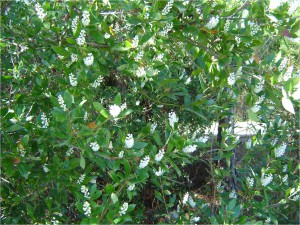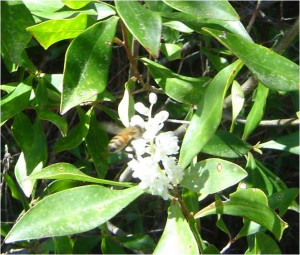
Black Titi in bloom. Flower clusters upright at tips of branches. An excellent source of nectar and pollen for honey production. Image: Alex Bolques
Black Titi (also known as Spring Titi or Buckwheat Tree (Cliftonia monophylla (Lam.) Britton ex Sarg. is a native shrub or tree that can be found growing along streams and boggy areas of the Florida Panhandle. It can tolerate acidic wetland soils and once established can also tolerate dry soils in the landscape. Black Titi can reach 15 – 30 feet in height with 3 – 4 inches of trunk diameter. Its bloom period lasts February through March.
Beekeepers love it because it is a wonderful source of nectar and pollen for honey production. Beginning beekeepers may confuse Black Titi with White Titi (also known as Summer Titi or Swamp Titi (Cyrilla racemiflora L.). It should not be grown as a honeybee pollinator plant. The nectar and/or pollen of White Titi can promote a condition known as “Purple brood”, which can be detrimental to honeybee immature stages.The flower of the spring flowering Black Titi is a raceme, a cluster of flowers along a central stem, that appears as an upright cluster on the tip of branches. The flower of the summer flowering White Titi is also a raceme, not as upright, more elongated. Visit the USDA Natural Resource Conservation Service plant database website and click on the image tab to see Black Titi (Buckwheat Tree) or White Titi (Swamp Titi) to view differences in flower morphology.
- Recycle By Cleaning Your Container Pots - July 28, 2015
- A Fluffy Woolly Mass on Woody Plants - June 17, 2014
- Preventing Heat Stress: Plant and People Considerations - May 13, 2014

